If you’re looking for a documentary about the U.S. porn industry, PBS now has the entire documentary “American Porn” available for free online.
sex
In the Girl and Boy Scouts, merit badges represent the acquisition of skills and knowledge. Artist Mary Yaeger tries to draw attention to the skills and knowledge that girls and women in America aquire, whether they be scouts or not, with her own set of embroidered merit badges. They feature things like tolerating menstrual cramps, shaving armpits, taking the birth control pill, suffering through gyn exams, using mascara and lipstick, learning how to walk in high heels, wearing sexy underwear, and more.
The project nicely reminds us that women have to work hard to appear properly feminine, as well as the unique things we experience as women.
Via Jezebel.
Lisa Wade, PhD is an Associate Professor at Tulane University. She is the author of American Hookup, a book about college sexual culture; a textbook about gender; and a forthcoming introductory text: Terrible Magnificent Sociology. You can follow her on Twitter and Instagram.
Will M. sent us this fascinating clip of Lil’ Wayne on Jimmy Kimmel Live. In the clip, Kimmel asks Wayne about losing his virginity at age 11. Wayne reveals that he did, indeed, lose his virginity at 11. He lost it to a 14-year-old girl who turned out the lights and surprised Wayne into participating, even as he had not intended doing so. What is fascinating is, were Wayne a white female, this narrative would have been considered molestation or rape. As a black male, doubly hypersexualized as a man (who always wants sex) and a black man (who really always wants sex), it’s just considered a joke. This is really nice evidence of the social construction of men, especially Black and Latino men, as hypersexual and, therefore, incapable of being sexually assaulted.
The discussion of his virginity loss begins at about 2:40.
Just one excerpt:
White guy: I didn’t know you could lose your viriginity at 11-years-old.
Other white guy: Well, we can’t, but he did.
Mercedes DeM. sent in this Vanity Fair cover (for April 2009)…
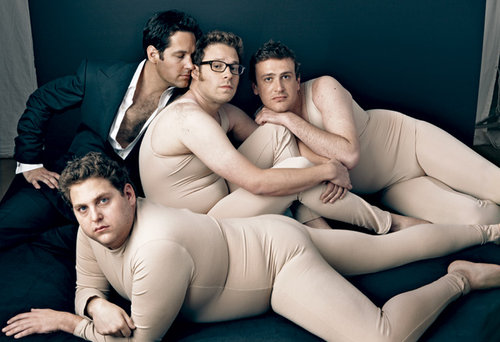
…spoofing this previous cover:

The women on the original cover are sex symbols. We should expect gratuitous nudity. The men in the spoof, in contrast, are comedians and so a direct comparison, arguing that men’s bodies are more off-limits, would be misguided. (Not that I think an argument couldn’t be made, but I don’t think this set of images supports it.)
Nor do I think that these images support the idea that we’re more accepting of variation in men’s bodies than women’s. If that were so, I think the men would actually be nude. Instead they’re covered up. My sense is that they’re covered up because their bodies are, according to rigid cultural standards, gross.
The relevant comparison, I think, would be between the spoof cover and a similar spoof cover featuring non-skinny women in nude body suits. The fact that the former is funny points to how men are allowed to be many things. They can be good-looking and fit, OR they can be not-so-good-looking, but rich, nice, or funny. And we still like them. There is no disdain for these men. We may even like them MORE because they’re willing to pose in ways that reveal how imperfect their bodies are.
I think we would be unlikely to see a similar cover featuring women, even women comedians, because women are allowed to be rich, nice, or funny but they must ALSO be good-looking and fit. A cover featuring chubby women would JUST be gross. It wouldn’t be gross and funny.
Being good-looking and fit is ONE way for men to be admire in our society. Being good-looking and fit is a REQUIREMENT for women to be admired, no matter what else she brings to the table.
I asked myself: in the entire history of Vanity Fair, would we be able to find three women with a similar body type to those men on the cover?
I found two, both featuring Roseanne Barr (images here and here):

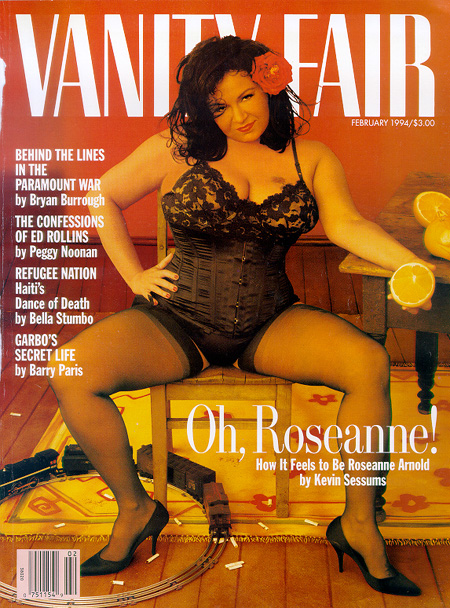
The covers feature a comedian who is well-known for being successful while bucking social expectations for women. She’s the exception to the rule that proves the rule. Or is she? I certainly think so. That “Oh, Roseanne!” is about how crazy she is.
In any case, notice that she’s still a sex symbol, while the men in the spoof are decidedly not. They’re spoofing such symbolism. Roseanne, despite her wacky resistance, still has to abide by it.
Britt Karp, Occidental College student and all-around great person, saw this public service notice on a subway in Manhattan:

Britt remarks:
Why is the message not – don’t sexually assault people?! Instead of reprimanding perpetrators of sexual assault (most frequently men), this poster places the responsibility on the person who is being assaulted (usually a woman). By doing this, it completely normalizes sexual harassment. The poster alludes to the argument touted by evolutionary psychologists – that it is in men’s nature to sexually assault women and so trying to control this behavior is futile. In this way, they make it seem that the only way to deal with this issue is for women to be braver. It’s no wonder women so frequently blame themselves when they are sexually assaulted.
NEW! Rachel McC. J., from Deeply Problematic, sent us another example of a poster asking women to stop men from behaving badly. This one targets young girls, telling them to turn away older men:
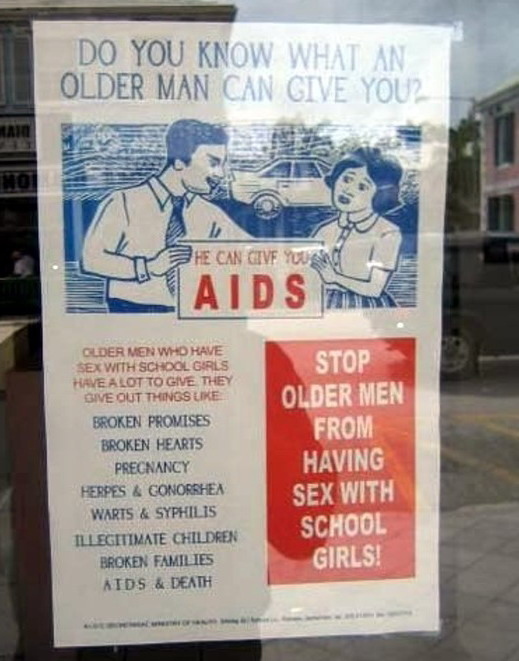
From the Pew Center on the States report, One in 31: The Long Reach of American Corrections, “Adding up all probationers and parolees, prisoners and jail inmates, you’ll find America now has more than 7.3 million adults under some form of correctional control. That whopping figure is more than the populations of Chicago, Philadelphia, San Diego and Dallas put together, and larger than the populations of 38 states and the District of Columbia. During Ronald Reagan’s first term as president, 1 in every 77 adults was under the control of the correctional system in the United States. Now, 25 years later, it is 1 in 31, or 3.2 percent of all adults.”


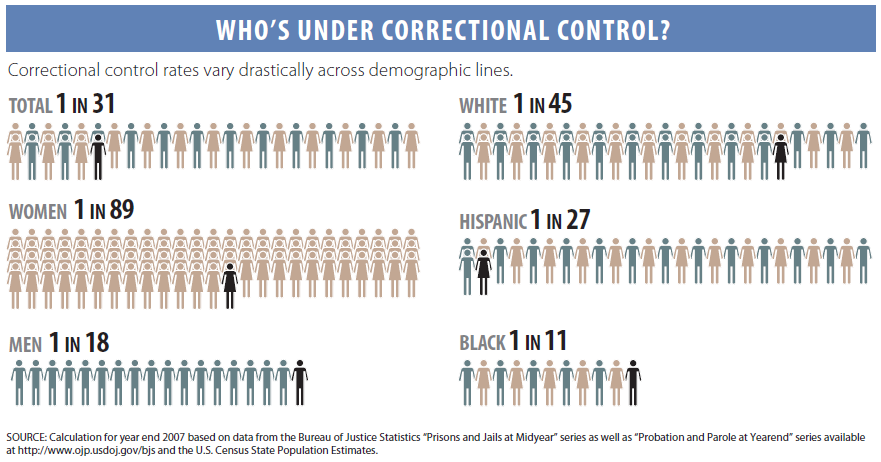 See the press release for a quick summary and the full report for much more data.
See the press release for a quick summary and the full report for much more data.
Those scamps at Patrón have come up with the following ad from their ” Some Perfection Is Debatable” campaign:
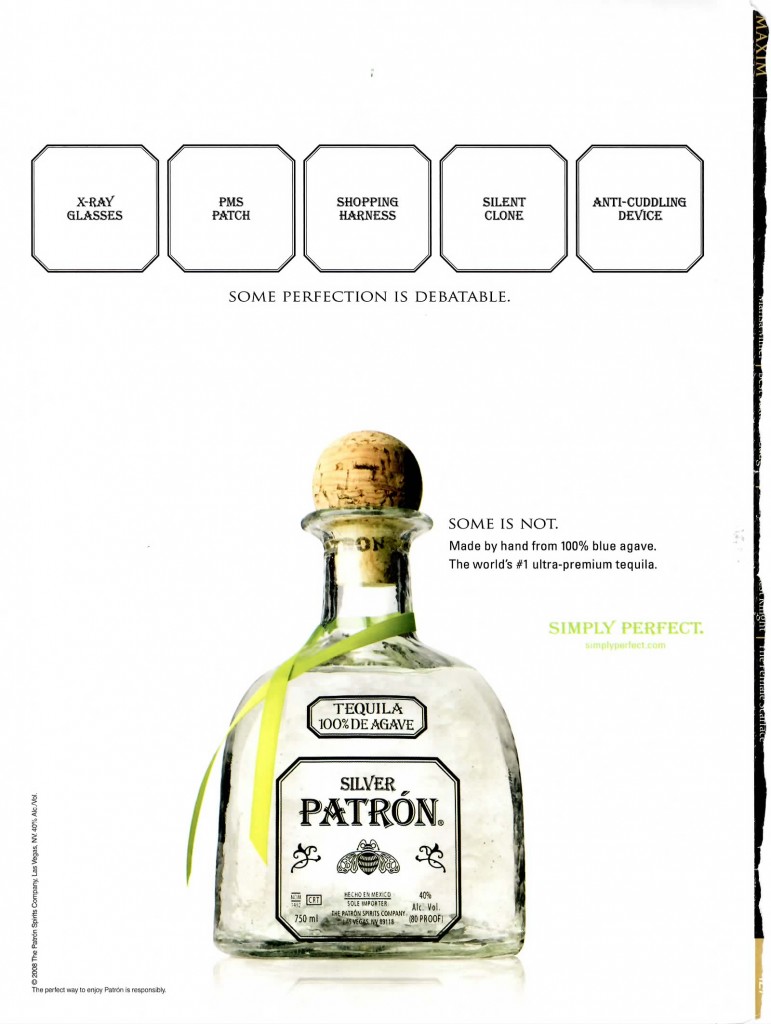
The following items apparently all represent perfection (debatably):
1. X-Ray Glasses: Dresses, locker rooms, bathroom stalls…the possibilities are limited only by your desire to look at the naked bodies of unconsenting women!
2. PMS Patch: Finally, a treatment for women whose behavior is intolerable because their hormonal levels are closest to men’s.
3. Shopping Harness: Presumably this would prevent shopping for girly stuff like purses and tampons. Buying video games and flat-screen TVs would be unaffected by the Harness. (When I pointed this out in class, a student told me “Women shop. Men purchase.”)
4. Silent Clone: At last, a woman who will only engage in sexual and domestic chores, without all of that troublesome talking!
5. Anti-Cuddling Device: Because after a rigorous, masculine bout of penile-vaginal intercourse, the last thing you want to do is something as gay as cuddling, am I right?
In addition to the obvious points the ad attempts to make about the inferiority of the feminine, it might be useful in a discussion about the smirking, elbow-in-the-ribs assumptions that are often a part of the enforcement of masculinity.
In the Girl and Boy Scouts, merit badges represent the acquisition of skills and knowledge. Artist Mary Yaeger tries to draw attention to the skills and knowledge that girls and women in America aquire, whether they be scouts or not, with her own set of embroidered merit badges. They feature things like tolerating menstrual cramps, shaving armpits, taking the birth control pill, suffering through gyn exams, using mascara and lipstick, learning how to walk in high heels, wearing sexy underwear, and more.
The project nicely reminds us that women have to work hard to appear properly feminine, as well as the unique things we experience as women.
Via Jezebel.
Lisa Wade, PhD is an Associate Professor at Tulane University. She is the author of American Hookup, a book about college sexual culture; a textbook about gender; and a forthcoming introductory text: Terrible Magnificent Sociology. You can follow her on Twitter and Instagram.
Will M. sent us this fascinating clip of Lil’ Wayne on Jimmy Kimmel Live. In the clip, Kimmel asks Wayne about losing his virginity at age 11. Wayne reveals that he did, indeed, lose his virginity at 11. He lost it to a 14-year-old girl who turned out the lights and surprised Wayne into participating, even as he had not intended doing so. What is fascinating is, were Wayne a white female, this narrative would have been considered molestation or rape. As a black male, doubly hypersexualized as a man (who always wants sex) and a black man (who really always wants sex), it’s just considered a joke. This is really nice evidence of the social construction of men, especially Black and Latino men, as hypersexual and, therefore, incapable of being sexually assaulted.
The discussion of his virginity loss begins at about 2:40.
Just one excerpt:
White guy: I didn’t know you could lose your viriginity at 11-years-old.
Other white guy: Well, we can’t, but he did.
Mercedes DeM. sent in this Vanity Fair cover (for April 2009)…

…spoofing this previous cover:

The women on the original cover are sex symbols. We should expect gratuitous nudity. The men in the spoof, in contrast, are comedians and so a direct comparison, arguing that men’s bodies are more off-limits, would be misguided. (Not that I think an argument couldn’t be made, but I don’t think this set of images supports it.)
Nor do I think that these images support the idea that we’re more accepting of variation in men’s bodies than women’s. If that were so, I think the men would actually be nude. Instead they’re covered up. My sense is that they’re covered up because their bodies are, according to rigid cultural standards, gross.
The relevant comparison, I think, would be between the spoof cover and a similar spoof cover featuring non-skinny women in nude body suits. The fact that the former is funny points to how men are allowed to be many things. They can be good-looking and fit, OR they can be not-so-good-looking, but rich, nice, or funny. And we still like them. There is no disdain for these men. We may even like them MORE because they’re willing to pose in ways that reveal how imperfect their bodies are.
I think we would be unlikely to see a similar cover featuring women, even women comedians, because women are allowed to be rich, nice, or funny but they must ALSO be good-looking and fit. A cover featuring chubby women would JUST be gross. It wouldn’t be gross and funny.
Being good-looking and fit is ONE way for men to be admire in our society. Being good-looking and fit is a REQUIREMENT for women to be admired, no matter what else she brings to the table.
I asked myself: in the entire history of Vanity Fair, would we be able to find three women with a similar body type to those men on the cover?
I found two, both featuring Roseanne Barr (images here and here):


The covers feature a comedian who is well-known for being successful while bucking social expectations for women. She’s the exception to the rule that proves the rule. Or is she? I certainly think so. That “Oh, Roseanne!” is about how crazy she is.
In any case, notice that she’s still a sex symbol, while the men in the spoof are decidedly not. They’re spoofing such symbolism. Roseanne, despite her wacky resistance, still has to abide by it.
Britt Karp, Occidental College student and all-around great person, saw this public service notice on a subway in Manhattan:

Britt remarks:
Why is the message not – don’t sexually assault people?! Instead of reprimanding perpetrators of sexual assault (most frequently men), this poster places the responsibility on the person who is being assaulted (usually a woman). By doing this, it completely normalizes sexual harassment. The poster alludes to the argument touted by evolutionary psychologists – that it is in men’s nature to sexually assault women and so trying to control this behavior is futile. In this way, they make it seem that the only way to deal with this issue is for women to be braver. It’s no wonder women so frequently blame themselves when they are sexually assaulted.
NEW! Rachel McC. J., from Deeply Problematic, sent us another example of a poster asking women to stop men from behaving badly. This one targets young girls, telling them to turn away older men:

From the Pew Center on the States report, One in 31: The Long Reach of American Corrections, “Adding up all probationers and parolees, prisoners and jail inmates, you’ll find America now has more than 7.3 million adults under some form of correctional control. That whopping figure is more than the populations of Chicago, Philadelphia, San Diego and Dallas put together, and larger than the populations of 38 states and the District of Columbia. During Ronald Reagan’s first term as president, 1 in every 77 adults was under the control of the correctional system in the United States. Now, 25 years later, it is 1 in 31, or 3.2 percent of all adults.”


 See the press release for a quick summary and the full report for much more data.
See the press release for a quick summary and the full report for much more data.
Those scamps at Patrón have come up with the following ad from their ” Some Perfection Is Debatable” campaign:

The following items apparently all represent perfection (debatably):
1. X-Ray Glasses: Dresses, locker rooms, bathroom stalls…the possibilities are limited only by your desire to look at the naked bodies of unconsenting women!
2. PMS Patch: Finally, a treatment for women whose behavior is intolerable because their hormonal levels are closest to men’s.
3. Shopping Harness: Presumably this would prevent shopping for girly stuff like purses and tampons. Buying video games and flat-screen TVs would be unaffected by the Harness. (When I pointed this out in class, a student told me “Women shop. Men purchase.”)
4. Silent Clone: At last, a woman who will only engage in sexual and domestic chores, without all of that troublesome talking!
5. Anti-Cuddling Device: Because after a rigorous, masculine bout of penile-vaginal intercourse, the last thing you want to do is something as gay as cuddling, am I right?
In addition to the obvious points the ad attempts to make about the inferiority of the feminine, it might be useful in a discussion about the smirking, elbow-in-the-ribs assumptions that are often a part of the enforcement of masculinity.

